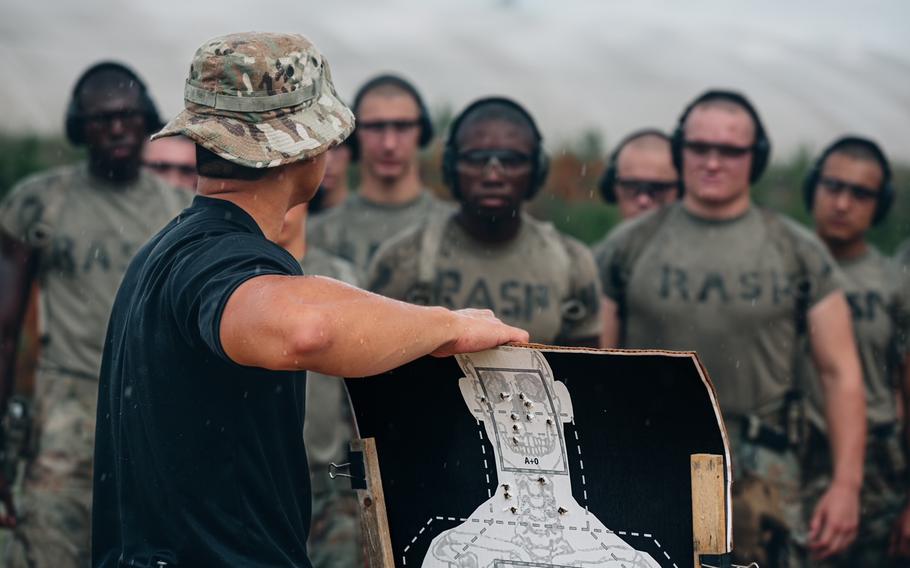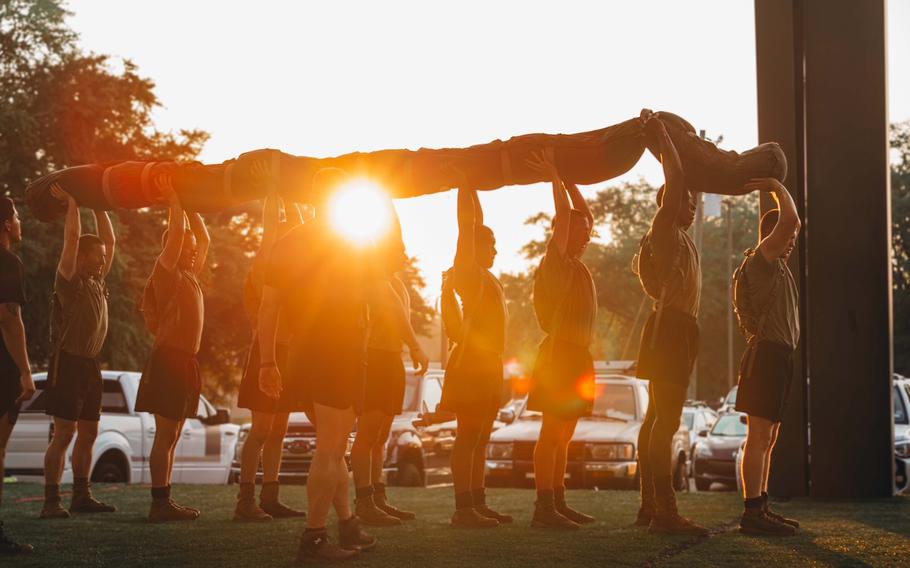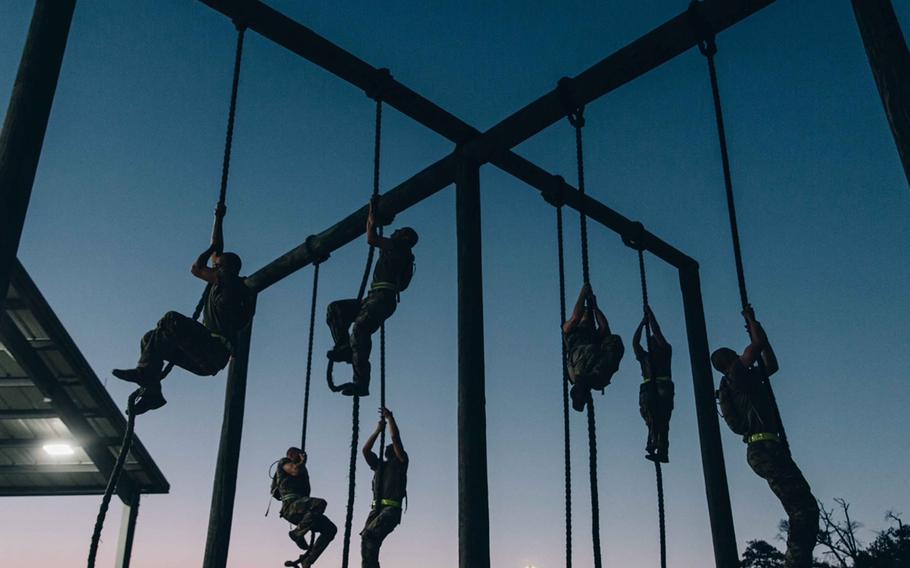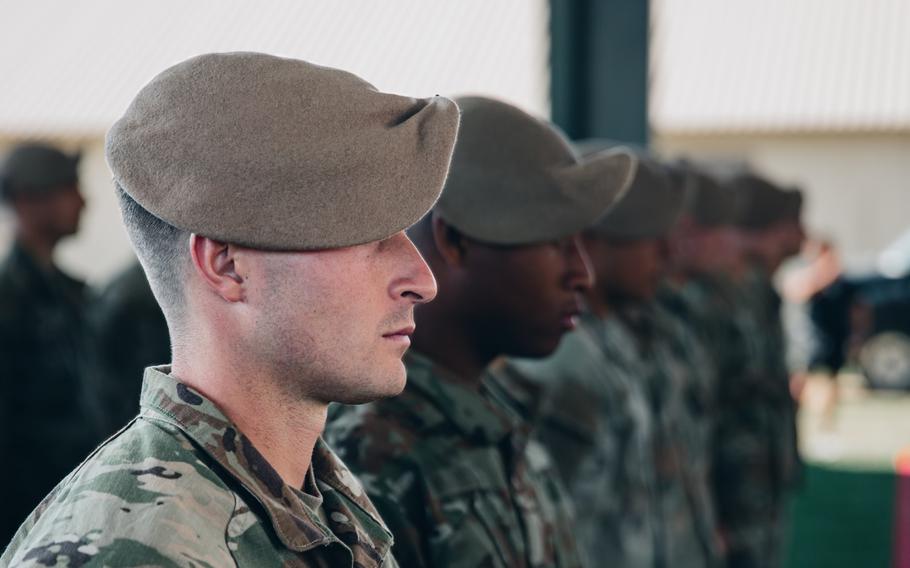.jpg/alternates/LANDSCAPE_910/XXXX%20RASP%20photo%2001%201.jpg)
Soldiers in the Army’s Ranger Selection and Assessment Program 1 course at Fort Moore train on the Georgia installation’s Cole Range on Oct. 25, 2023 as they attempt to earn spots in the elite 75th Ranger Regiment. (Corey Dickstein/Stars and Stripes)
FORT MOORE, Ga. — Exhausted after three straight days of intense training exercises that took the young soldiers more than 50 miles on foot, they plopped down against pine trees just inside the wood line on the post’s Cole Range.
One of the soldiers — a private — limped his way through the center of the makeshift defensive formation of tired troopers, insisting to a noncommissioned officer checking on his conditions that he was “all good, sergeant,” and only suffering from minor chafing. Two more soldiers limped past the same NCO, telling him that they, too, were good to go and ready to continue their attempts to earn a spot in one of the Army’s most elite formations — the 75th Ranger Regiment.
“They’re gonna make it,” said Army 1st Sgt. Tyler Fillion, the senior enlisted leader for the Fort Moore-based regiment’s Selection and Training Company. “They want it. They’re tough.”
Fillion carefully watched the latest class of Ranger hopefuls navigate the eight-week course to earn a spot in the special operations formation known as Ranger Assessment and Selection Program 1, or RASP 1.
“Look, at this point, everyone’s broken,” he said. “They’re going to end up going 80 miles or something on foot by the end of today. Everyone is at the baseline of just, ‘Ouch.’ We’re looking for those guys and girls who can put that aside, put their head down and keep getting after it. If you can do that. If you can show you want it, we’re probably going to take you.”

Ranger candidates pictured during marksmanship in an iteration of a Ranger Assessment and Selection Program in 2023. The course qualifies soldiers to serve in the elite Ranger Regiment. (Landon Carter/75th Ranger Regiment)
Each year more than 1,000 soldiers — the vast majority being new troops fresh out of Army initial entrance training — come to Fort Moore, the former Fort Benning, to attempt to join the legendary Ranger Regiment, according to data provided by the unit. Somewhere between 30% and 50% of those who start the eight yearly RASP 1 courses will earn the Ranger’s coveted tan beret and a spot in the regiment that has for decades produced some of the Army’s highest achieving soldiers.
The special operations unit, which includes combat battalions at Hunter Army Airfield, Ga., Joint Base Lewis-McChord, Wash., and Fort Moore, where the regiment and its military intelligence apparatus are headquartered, was among the U.S. military’s most heavily deployed formations during operations in Afghanistan, Iraq and Syria during the Global War on Terror.
The unit’s soldiers earned countless valor and combat medals — including two Medals of Honor — and Purple Hearts as they carried out dangerous, classified combat operations nearly daily for some 20 years. In recent years, the regiment’s Rangers have dominated Army soldier competitions in the U.S., with 75th Rangers winning the last three Best Ranger Competitions among others, including 2023’s Best Mortar and Best Squad competitions.
Fillion, a longtime Ranger who joined the 75th via RASP 1 as a sergeant in 2010 after serving two deployments to Iraq in the conventional Army, said the RASP programs that he has helped oversee for the last year and a half play a critical part in ensuring the Ranger regiment retains its reputation as the Army’s premier light infantry and direct-action raid force. From the first day when Ranger hopefuls enter the regiment’s pre-RASP program — a Ranger-run course meant to get soldiers in shape to succeed at RASP 1 — they are introduced to the unit’s unique culture, which Fillion said is built around teamwork, the dedication to mental and physical excellence and the will to continue the mission at all costs.
The secretive unit has long shied away from media attention, but it recently invited Stars and Stripes to observe some of the training in RASP 1 and RASP 2, a similar, shorter Ranger assessment program for staff sergeants through captains to earn leadership positions in the 75th Ranger Regiment. Though unit leaders were careful not to reveal specific details about the RASP courses to ensure future candidates enter the program with limited knowledge of what to expect, they offered some insights of how physically grueling and mentally taxing the Ranger tryouts can be.
That is by design, Fillion noted. Rangers must be prepared to go to combat at any time, if events in their selection course are “as difficult as the worst day of combat,” then they can enter any situation knowing they can succeed, he said. But as the Army — and the military overall — faces unprecedented recruiting challenges at a time when fewer young Americans than ever have an interest in military service or even qualify to enter the ranks, Fillion has a message to anyone with even the slightest interest in becoming a Ranger: Come try out.
“We have people who think they need to be an Olympic athlete, you need to be a Division I [college] athlete to come here, and that’s not the case,” Fillion said. “You have to have a certain type of inner resolve, but you don’t need to be [Olympic swimmer] Michael Phelps … or Mr. ultramarathon runner — you need the drive to want to harden yourself to have that kind of resolve.”
So, what qualities are Fillion and his Ranger cadre looking for in those who earn the tan beret? A never-quit, team-first attitude, and a dedication to the eight Army special operations attributes: Integrity, courage, perseverance, personal responsibility, professionalism, adaptability, teamwork and capability, Fillion said.

Army soldiers in the 75th Ranger Regiment’s Ranger Assessment and Selection Program conduct physical training with a worm during an iteration of RASP in 2023. The course qualifies soldiers to serve in the elite Ranger Regiment. (Landon Carter/75th Ranger Regiment)
The physicality for which the Rangers are known will come once a soldier joins the unit and is subjected to its purpose-built physical training program run by strength and conditioning experts. The unit holds all its troops from the infantrymen who make up the majority of the 3,000-Ranger regiment to its lawyers and human resources officers to stringent, higher-than-normal fitness and conditioning standards.
“If somebody’s physically weak, we’ll get them stronger,” Fillion said. “If they have the desire and the other attributes — they’re getting hired, and we’ll build them up.”
RASP 1
In January 2010, after almost a decade of war in Afghanistan and Iraq, the 75th Ranger Regiment scrapped its long-held selection process known as the Ranger Indoctrination Program, or RIP, in favor of a longer, more skill-focused program in RASP 1. The new program for soldiers in the ranks of E-1 to E-5 added a second, four-week phase to RIP’s program, which aimed to provide new Rangers with the skills that they would need in the intense combat that they were almost assured to find once they joined their units.
“We were taking people straight from RIP, and 90 days later they were in a pretty kinetic environment, whether it’s Baghdad or Afghanistan, so they said, ‘Hey, how can we provide a better product?’” Fillion said. “The first four weeks really remain the same as RIP — and that’s the assessment of who the candidates are. Then, the second four weeks are about the training, still assessing, but giving them the skills they need to succeed at their battalion on marksmanship, demolition, those things that they need so we can provide a better warfighter to the unit.”
The eight yearly iterations of RASP typically begin with 135 to 170 Ranger candidates, said Tracy Bailey, a spokeswoman for the 75th Ranger Regiment. They are led by a noncommissioned officer cadre purposely selected from across the regiment, said Fillion, who added cadre members were among the highest performing NCOs in the 75th.

Ranger candidates climb ropes during physical training as part of the Ranger Assessment and Selection Program in April 2023, which qualifies soldiers to join the 75th Ranger Regiment. (Landon Carter/75th Ranger Regiment)
He called the cadre RASP 1’s “special sauce” because they lead from the front, conducting all the training right alongside the Ranger candidates. When RASP 1 candidates conduct PT sessions, the cadre do the same exercises, often with more weight, Fillion said.
“Everything the candidates do, the cadre is doing,” he said. “The leaders go first. There should be someone out here showing [Ranger candidates] what the expectation is all the time. Because they don’t have a model for that … And that sets the model and their minds that when they go to their Ranger battalion, they’re going to be led by an NCO who doesn’t say, ‘Do what I say,’ they’re going to say, ‘Hey, follow me. I’m going to teach you how to do this because I’m going to do it, too.’”
Many of the events that Ranger candidates face are linked to the unit’s legacy from operations in World War II such as the Cabanatuan Raid, which saw Rangers sneak behind Japanese lines to free some 500 American prisoners in the Philippines, and Operation Gothic Serpent, the 1993 Battle of Mogadishu in Somalia depicted in the book and movie “Black Hawk Down.” The RASP 1 course even includes a history test for Ranger candidates, Fillion said.
The unit’s storied history is part of its culture, he said. Tying the regiment’s past accomplishments to candidates suffering allows them to embrace that legacy.
Fillion said the first two weeks of RASP 1 are easily the most intense — designed to bring young soldiers to the brink of their mental and physical capabilities.
Throughout the course, soldiers low crawl across long distances, ruck march for miles with heavy loads, fight hand-to-hand, face mass casualty events and strenuous workouts that push most candidates to the brink, Fillion said.
“We want them to leave this program, knowing that when we put them in a Ranger battalion, and they’ve got to go to the top of that mountain, they’re gonna get there,” he said. “And we want them to know that they have the reservoir of strength to be able to go there.”
RASP 2
For higher-ranked soldiers looking to enter the 75th Ranger Regiment and for its seasoned Rangers attempting to earn new leadership roles in the formation, RASP 2 is meant to challenge their ability to make good decisions under physical and mental stress.
The three-week course is meant to validate soldiers — including longtime Rangers — in the ranks of staff sergeant to captain as prepared to lead Rangers, Fillion said. While RASP 1 focuses largely on training, RASP 2 is about proving the skills that soldiers already possess.
On a recent day on Cole Range, several dozen RASP 2 candidates spent hours on various challenges that included long runs and mental puzzles squeezed between brief strength training sessions and obstacle courses.
After completing one of the sessions, a longtime Ranger, Sgt. 1st Class Moore — whose first name was withheld by public affairs officials citing U.S. Army Special Operations Command security policy — described the course as “very physically and mentally taxing.”
The physical activities and puzzles are meant to demonstrate a Ranger’s ability to think clearly and make quick decisions under the stressors of combat, said Fillion, who has completed RASP 2 twice and might attend again next year, if he is selected for a sergeant major position in the Ranger regiment. The repetitive validation of everyone in the regiment’s senior ranks — including validation courses for top officers such as battalion and regimental commanders — is part of what makes the unit run smoothly and maintain its elite fighting capabilities, Fillion said.
For Moore, an infantryman and veteran of five combat tours who has served in the Ranger Regiment since he enlisted in 2011, passing RASP 2 would earn him a promotion to a Ranger platoon sergeant. He said he found the physical requirements for RASP 2 similar to RASP 1, but RASP 2 candidates must come with greater knowledge.

New Army Rangers don their tan berets after graduating a Ranger Assessment and Selection Program course at Fort Moore, Ga., in March 2023. (Landon Carter/75th Ranger Regiment)
“[The cadre] is not here to teach you, they’re here to validate,” Moore said. “RASP 1 is more about teaching you how to be physically fit, how to maintain your physicality, how to land navigate. … In RASP 2 those are skills you better already have.”
He said teamwork was the key to success in the course. Like Filion, he encouraged those interested in joining the Rangers to come to RASP and give it a shot — especially if they are willing to be humbled.
“If you have the drive to serve, the 75th Ranger Regiment is where you want to do it,” Moore said. “If you want to constantly be pushed to be better and feel inferior to all your peers and grow thick skin — the 75th Ranger Regiment is where to do it. It’s worth every bit of the struggle.”
Fillion concurred. Becoming a Ranger is not easy, the first sergeant said, but those who earn their way into the unit have accomplished something incredible.
“Not only do they earn their spot, they continue to earn it every day, they continue to meet the standard, they continue to better themselves, and they continue to better those around them,” Fillion said. “Then we take it a step further and revalidate all of the senior leaders around this formation — they’ve not only proved themselves and earned their spot, but they continue to do it over and over and continue to prove they belong here.”